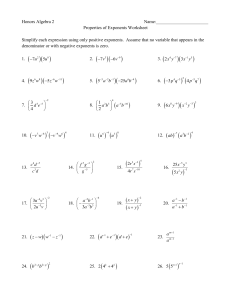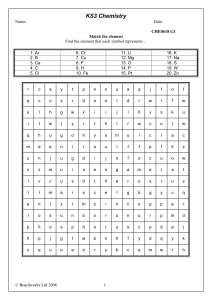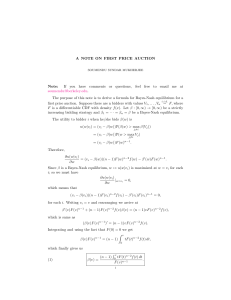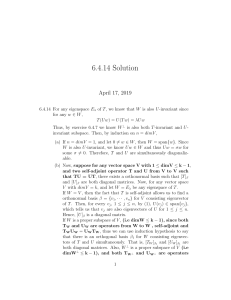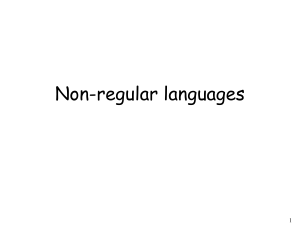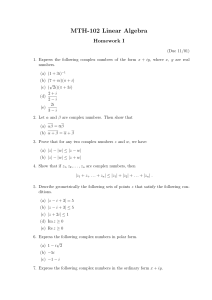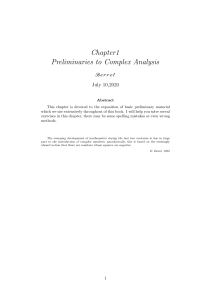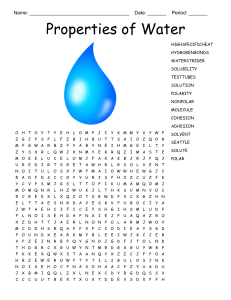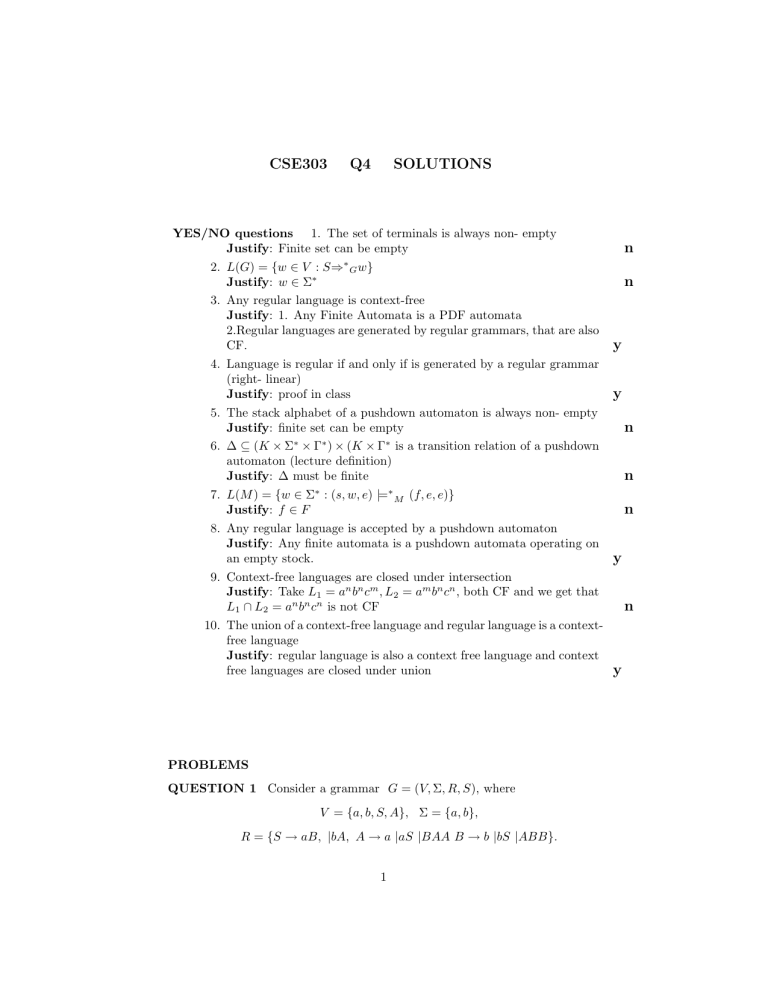
CSE303
Q4
SOLUTIONS
YES/NO questions 1. The set of terminals is always non- empty
Justify: Finite set can be empty
2. L(G) = {w ∈ V : S⇒∗ G w}
Justify: w ∈ Σ∗
3. Any regular language is context-free
Justify: 1. Any Finite Automata is a PDF automata
2.Regular languages are generated by regular grammars, that are also
CF.
4. Language is regular if and only if is generated by a regular grammar
(right- linear)
Justify: proof in class
5. The stack alphabet of a pushdown automaton is always non- empty
Justify: finite set can be empty
6. ∆ ⊆ (K × Σ∗ × Γ∗ ) × (K × Γ∗ is a transition relation of a pushdown
automaton (lecture definition)
Justify: ∆ must be finite
7. L(M ) = {w ∈ Σ∗ : (s, w, e) |=∗ M (f, e, e)}
Justify: f ∈ F
8. Any regular language is accepted by a pushdown automaton
Justify: Any finite automata is a pushdown automata operating on
an empty stock.
9. Context-free languages are closed under intersection
Justify: Take L1 = an bn cm , L2 = am bn cn , both CF and we get that
L1 ∩ L2 = an bn cn is not CF
10. The union of a context-free language and regular language is a contextfree language
Justify: regular language is also a context free language and context
free languages are closed under union
PROBLEMS
QUESTION 1 Consider a grammar G = (V, Σ, R, S), where
V = {a, b, S, A}, Σ = {a, b},
R = {S → aB, |bA, A → a |aS |BAA B → b |bS |ABB}.
1
n
n
y
y
n
n
n
y
n
y
1. Show that ababba ∈ L(G).
Solution The following derivation proves that ababba ∈ L(G).
S ⇒ aB ⇒ abS ⇒ abaB ⇒ ababS ⇒ ababbA ⇒ ababba
3. Give a property defining the L(G). Justify shortly your answer.
Case 1 We start with S → aB. The next steps are applications of rules:
R1 : B → b, R2 : B → bS, or R3 : B → ABB. By R1 we get ab ∈ L, by
R2 we get aABB and A can become a, or aS, or BAA, in all cases we get
words with the same number of a’s and b’s.
Case 2 we start with S → aB. Th enext step is application of B rules and the
”way out”. We can see that in this case we will also get words with the
same number of a’s and b’s.
L(G) = {w ∈ {a, b}∗ : w has the same number of a0 s and b0 s
QUESTION 2 Construct a context-free grammar G such that
L(G) = {wcwR : w ∈ {a, b}∗ }.
Justify your answer.
Solution Σ = {a, b, c}, V = Σ ∪ {S},
R = {S → aSa|bSb|c}
Example of a derivation:
S ⇒ aSa ⇒ abSab ⇒ abcba
Remark that the set of rules
R = {S → aSa|aSb|e}
defines a grammar with
L(G) = {wwR : w ∈ {a, b}∗ }.
QUESTION 3 Construct a context-free grammar G such that
L(G) = {w ∈ {a, b}∗ : w has twice as many b0 s as a0 s}.
Justify your answer.
Solution: G = (V, Σ, R, S), where V = {S, a, b}, Σ = {a, b}.
The set R of rules contains the following rules:
2
S −→ e,
S −→ Sabb|aSbb|abSb|abbbS, S −→ Sbab|bSab|baSb|babS,
S −→ Sbba|bSba|bbSa|bbaS.
DEFINITION A context-free grammar G = (V, Σ, R, S) is called regular iff
R ⊆ (V − Σ) × Σ∗ ((V − Σ) ∪ {e})
QUESTION 4 Given a Regular grammar G = (V, Σ, R, S), where
V = {a, b, S, A, B}, Σ = {a, b},
R = {S → abA |B | baB |e, A → bS |b, B → aS}.
1. Construct a finite automaton M , such that L(G) = L(M ). You can draw a
diagram.
Solution M = (K, Σ, s, F, ∆) for K = {S, A, B, f }, Σ = {a, b}, s = S, F = {f },
∆ = {(S, ab, A), (S, e, B), (A, ba, B), (S, e, f ), (A, b, S), (A, b, f ), (B, a, S)}
2. Trace a transitions of M that lead to the acceptance of the string abba, and
compare with a derivation of the same string in G.
M
M
M
M
M
M
(S, abba) ` (A, ba) ` (S, a) ` (B, a) ` (B, a) ` (S, e) ` (f, e)
This means that
∗,M
(Sabba) ` (f, e)
and abba ∈ L(M ).
The corresponding Derivation in G is:
S ⇒ abA ⇒ abbS ⇒ abbB ⇒ abbaS ⇒ abba
QUESTION 5
1. Construct a pushdown automaton M such that
L(M ) = {w ∈ {a, b}∗ : w = wR }
Solution M = (K, Σ, Γ, ∆, s, F ), where
K = {s, f }, Σ = {a, b}, Γ = {a, b}, F = {f }, s = s,
∆ = {((s, a, e), (s, a)), ((s, b, e), (s, b)), ((s, e, e), (f, e)),
((s, a, e), (f, e)), ((s, b, e), (f, e)), ((f, a, a), (f, e)), ((f, b, b), (f, e))}
3
2. Trace a transitions of M that lead to the acceptance of the string ababa.
Solution
s
ababa
e
s
baba
a
s
aba
ba
f
ba
ba
f
a
a
f
e
e
QUESTION 6 Show that L = {ww : w ∈ {a, b}∗ } is not CONTEXT-Free.
Solution We know that the language
L1 = {ai bj ai bj : i, j, ≥ 0}
is NOT Context Free.
We have a THEOREM :
CF ∩ REG = CF
i.e that intersection of a CF language with a REGULAL language is a CF
language.
proof: Assume that L is a CF language. By the Theorem, L ∩ a∗ b∗ a∗ b∗ must
be a CF language, but
L ∩ a∗ b∗ a∗ b∗ = {ai bj ai bj : i, j, ≥ 0} = L1
and we have a contradiction.
QUESTION 7 Construct a context-free grammar G such that
L(G) = {w ∈ {a, b}∗ : w = wR }.
Justify your answer.
Solution G = (V, Σ, R, S), where
V = {a, b, S}, Σ = {a, b},
R = {S → aSa |bSb | a | b | e}.
Derivation example: S ⇒ aSa ⇒ abSba ⇒ ababa
ababaR = ((ab)a(ba))R = (ba)R aR (ab)R = ababa.
4
Observation 1 We proved in class that for any x, y ∈ Σ∗ , (xy)R = y R xR .
From this we have that
(xyz)R = ((xy)z)R = z R (xy)R = z R y R xR
Grammar correctness justification: observe that the rules S → aSa |bSb | e
generate the language L1 = {wwR : w ∈ Σ∗ }. With additional rules
S → a | b we get hence the language L = L1 ∪{wawR : w ∈ Σ∗ }∪{wbwR :
w ∈ Σ∗ }. Now we are ready to prove that
L = L(G) = {w ∈ {a, b}∗ : w = wR }.
Proof Let w ∈ L, i.e. w = xxR or w = xaxR or w = xbxR . We show that in
each case w = wR as follows.
c1: wR = (xxR )R = (xR )R xR = xxR = w (used property: (xR )R = x).
c2: wR = (xaxR )R = (xR )R aR xR = xaxR = w (used Observation 1 and
properties: (xR )R = x and aR = a).
c3: wR = (xbxR )R = (xR )R bR xR = xbxR = w
properties: (xR )R = x and bR = b).
5
(used Observation 1 and
